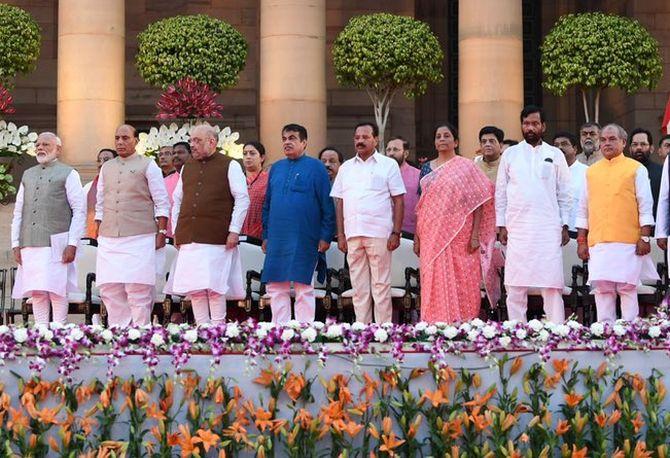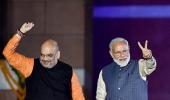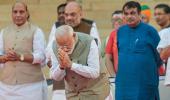'The Modi Model we see now is still the old Gujarat Model.'
'But with an acknowledgement that governing India is more challenging than governing Gujarat,' notes Shekhar Gupta.

The Modi-Shah-BJP establishment has an aversion to anyone but the faithful using the expression 'Gujarat Model' to characterise their methods.
We can see where they are coming from.
Their critics have trade-marked that expression to mean their post-2002 politics of polarisation.
There is, however, a less contentious manifestation of the Gujarat Model as well: Centralised governance.
Watch the latest changes in the mrime minister's office, with three of his key aides being elevated to cabinet rank, setting a precedent.
This is natural progression from the way Narendra Damodardas Modi ran Gujarat.
But, for everyone's comfort, let's simply call it the Modi Model of Governance.
It was unveiled in Gujarat in 2001-2902, evolved through his two full terms (2002-2012) and two part terms (2001-2002, 2012-2014), and accompanied him to New Delhi.
His second term as PM is its reinforced version.
If you are risk-averse, you might wish to borrow that statutory warning from mutual funds: Past performance is not a guarantee of future performance.
Such caveats are not available to us, political analysts, as our published word lives on for public scrutiny.
With Mr Modi, however, it has so far been quite safe to apply his past to his future action.
Much can change, but in detail.
The fundamentals remain firm.
Here are the five important pillars of this Modi Model:
- 1. 'Supremo' chief executive with total control of the party through trusted lieutenants;
- 2. Governance through hand-picked civil servants, and retirement won't come in the way;
- 3. Mission-mode governance with a few ideas where visible results are possible within one term, to be executed by a few chosen people;
- 4. Never lose the ideological big picture;
- 5. Neutralise all opposition, within and outside, through reason, rent, pressure and intrigue (the ancient saam, daam, dand, bhed).
It worked brilliantly in Gujarat, a medium-sized and less diverse state.
There were doubts if it would work for all of India.
It did threaten to unravel a few times: Demonetisation, some foreign policy setbacks, especially in the neighbourhood after the initial euphoria, growth decline, job losses and the 2017 Gujarat election near-thing.
But in the end, what matters is the bottom line.
The 303 there settled it.
Like all capital cities, New Delhi's first instinct is bureaucratic: Mr Modi had no choice but to elevate his three aides.
After he chose former IFS officer S Jaishankar to be his external affairs minister, he was under compulsion to upgrade National Security Advisor and former IPS officer Ajit Doval to avoid an awkward rank-reversal.
Having promoted Mr Doval, in turn, Mr Modi was forced to give parity to Nripendra Misra and P K Mishra from the IAS.
You should be careful to read too much in these, mere protocol compulsions.
Other non-ministers have been given Cabinet rank in the past, notably the heads of the Planning Commission and NITI Aayog and, under UPA-2, even Nandan Nilekani as head of the UIDAI.
This explanation fails for three reasons.
First, because it is so obvious that in the Modi world it is illogical.
Second, because it presumes Mr Modi had to make these changes under compulsion.
There is nothing on Mr Modi's record yet that says he is prone to acting under compulsion, definitely not of bureaucratic protocol.
Why would he do it now after winning an enhanced majority? And third, that nothing compelled him to pick Mr Jaishankar in the first place.
He did that to a larger plan and the follow-on changes are merely elements of it.
This PMO, accordingly, is resembling the US president's executive office with the power of key Cabinet officers (ministers) exercised from here.
The PMO grew in Mr Modi's first term and controlled the ministries of his focus directly, from foreign affairs to sanitation.
Now, its leaders have grown, to the level of the Cabinet ministers they hold to account on their boss's behalf.
So even the pretence of a Westminster-style cabinet system, where the PM is the first among equals, is over.
Think of a particularly hands-on American president running the state and defense departments through a trusted NSA straddling both and an equally powerful White House chief of staff.
Except, that in Mr Modi's case now he has two chiefs of staff.
Indira Gandhi invented the position of principal secretary in 1971 and appointed P N Haksar there.
Haksar was followed by V Shankar under then prime minister Morarji Desai.
The position was then briefly abolished as Charan Singh's Janata fovernment detested centralisation.
It returned with Mrs Gandhi in 1980 with P C Alexander.
There was one more difference now.
Pre-1977, she still had some powerful ministers in her Cabinet, including Jagjivan Ram.
Now she had almost none.
The only minister with some power was probably a young Pranab Mukherjee.
This is what comes closest to Mr Modi in his second term with some differences.
First, he doesn't lead his party directly, but through Amit Anilchandra Shah.
Second, unlike Mrs Gandhi, whose ideological objective was continuity, his is change, especially in the way Indian secularism has been defined by the Gandhi family.
He told us that in his first speech to his party on the day of the results.
And third, he has no family or dynasty.
In that sense too, he is comparable with a US president.
Not entitled to infinite terms, although not limited to two like him either.
After him, there may be another party leader. Not other Modis.
A legitimate criticism of Mr Modi's first government has been its lack of talent.
I too have fretted about it, describing it as the most talent-averse establishment in independent India.
The reason those close to him gave then was, so what if we do not have talent and experience.
We will learn.
But we aren't going to win power and gift it to others.
That, in a way, was a repudiation of the Vajpayee school of team-building.
He had drawn talent from everywhere.
Jaswant Singh was non-RSS, Yashwant Sinha and Rangarajan Kumaramangalam were recent entrants to the BJP, George Fernandes was the first and last non-BJP, non-Congress minister in the Cabinet Committee of Security yet in a coalition led by either.
Arun Shourie was a powerful change agent who brought the force of his intellect and integrity from outside.
Mr Modi and Mr Shah did the opposite in their first term.
They were averse to giving any political space to outsiders.
They also had a deep distrust of professionals, specialists and technocrats.
The fate of the two RBI governors with a formidable academic reputation is evidence.

Critics like us were dismissed as being outdated in our thinking, or unwilling to accept that a government could be run well without faces familiar to Anglicised Delhi elites.
By the fourth year, however, as the economy floundered, and after some state election and by-election setbacks, there were signs of change.
The latter reshuffles saw the lateral entry of retired civil servants, like former IAS officer R K Singh and former IFS officer Hardeep Puri.
They've both risen in stature.
See the induction of Mr Jaishankar at such a high level as a logical progression from there.
And ditto for the elevation of the PMO trio.
The two programmes closest to Mr Modi's heart and politics -- sanitation-water (combined now) and Ayushman Bharat -- are with two empowered former civil servants, Parameswaran Iyer and Indu Bhushan, respectively, brought back from the World Bank/ADB and re-employed.
The Modi Model we see now is still the old Gujarat Model.
But with an acknowledgement that governing India is more challenging than governing Gujarat, the talent it needs isn't all available in the BJP, and he will now reach outside.
But only to those he has known and trusted over time within their career services.
Keep a close watch in this term on a presidential Prime Minister Modi, governing through his 'Cabinet' of super-bureaucrats.
By Special Arrangement with The Print











